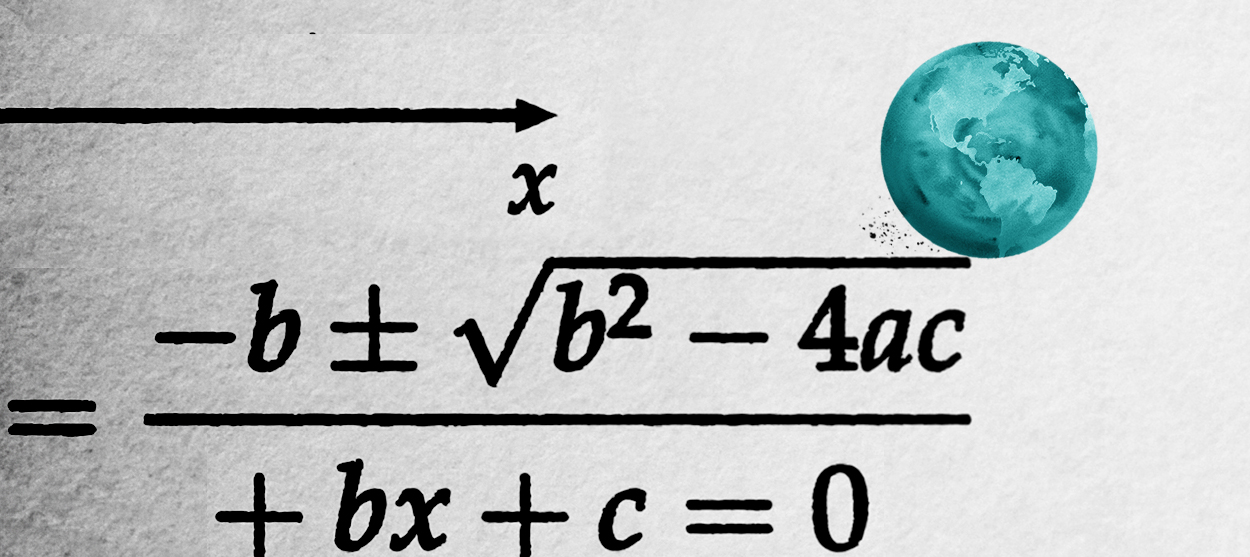The Earth is not a math problem
Why a technocratic approach to the environment is doomed to fail


"The earth, our home," Pope Francis wrote, "is beginning to look more and more like an immense pile of filth." That was five years ago. Many observers, not only in secular media but in "conservative" Catholic circles as well, misunderstood the point of his encyclical on the subject of what he calls "human ecology" by insisting that its theme was climate change.
This is a very narrow understanding of the great crisis of our age, the dimensions of which transcend graphs and their apparently alarming upward-sloping lines. The problem of human ecology that we are confronted with is the absorption of all creation into a sinuous continuum of decontextualized economic exchange. It has distinct but overlapping political, social, economic, and, of course, spiritual and ecological dimensions. Its urgency is such that the Holy Father has addressed many of his recent pronouncements not merely to the Catholic faithful but to all persons of good will throughout the world.
One reason that Francis's perspective on what we are used to thinking of as "the environment" is so valuable is that he reminds us that it is not an abstract problem. It will not be solved by a technocratic mindset — projections for carbon tax rates that economists believe could get the chart down to zero by or ahead of a certain date — that is among its primary causes. Nor can it be addressed by schemes like the Green New Deal, which are premised upon remaking everything that is wrong with consumer capitalism in the image of woke 20-something professionals.
The Week
Escape your echo chamber. Get the facts behind the news, plus analysis from multiple perspectives.

Sign up for The Week's Free Newsletters
From our morning news briefing to a weekly Good News Newsletter, get the best of The Week delivered directly to your inbox.
From our morning news briefing to a weekly Good News Newsletter, get the best of The Week delivered directly to your inbox.
One of the most obvious problems with the managerial approach to climate change is the disdain in which many climate scientists hold policies meant to limit the use of single-use plastics. After all (they argue) our calculations suggest that banning disposable bags will result in only a negligible reduction in global emissions. It would be far wiser to ask the Group of 8 Nations to sign a treaty full of meaningless verbiage and "targets" that can always be met by creative statisticians — the same gaming of metrics that gave rise to the problems they are hoping to address.
What these contrarians miss is the fact that waste is a bad thing for its own sake, that the disposability of so many of the objects that surround us disfigures not only the planet but our own appetites and imaginations. The measurability of waste is beside the point because the earth is not a math problem. If scientists could demonstrate tomorrow that our oceans were being made healthier by all the trash they contain and that birds were enjoying longer lifespans thanks to their consumption of plastic rubbish, our throwaway culture would still be disordered.
This is true above all because, however transient our relations with the items — most of them made by wage slaves — that we discard without a thought each day might be, the consequences of their disposal will be with us for thousands of years. The future of life on this planet is billions of polyethylene diapers slowly poisoning the soil or (more likely) toxifying the air centuries after our great buildings have crumbled.
Some of us might be willing to countenance all of this so long as we imagine gigantic heaps of rubbish in places that do not exist on maps. But now we read that even the summit of Mount Everest is becoming a trash heap, its snows soaked with micro-plastics, its famous Base Camp the preserve of cast-off water bottles and fragments of synthetic fiber.
A free daily email with the biggest news stories of the day – and the best features from TheWeek.com
Can you graph the Himalayas? Is there a statistical threshold of waste measured against GDP that would make us okay with the idea of this sublime vista looking like the parking lot of a McDonald's, its ancient peaks the haunt of short-sighted experiments by chemical engineers chasing meaningless profits? The prospect of human extinction raised by climate scientists is a fantasy that distracts us from the real question: What sorts of human beings will live in an utterly spoiled world, centuries or millennia after their ancestors traded beautiful mountains for ones made of Paw Patrol action figures?
Matthew Walther is a national correspondent at The Week. His work has also appeared in First Things, The Spectator of London, The Catholic Herald, National Review, and other publications. He is currently writing a biography of the Rev. Montague Summers. He is also a Robert Novak Journalism Fellow.
-
 ‘They’re nervous about playing the game’
‘They’re nervous about playing the game’Instant Opinion Opinion, comment and editorials of the day
-
 Will Netanyahu get a pardon?
Will Netanyahu get a pardon?Today's Big Question Opponents say yes, if he steps down
-
 December’s books feature otherworldly tales, a literary icon’s life story and an adult royal romp
December’s books feature otherworldly tales, a literary icon’s life story and an adult royal rompThe Week Recommends This month's new releases include ‘The Heir Apparent’ by Rebecca Armitage and ‘Tailored Realities’ by Brandon Sanderson
-
 Has Zohran Mamdani shown the Democrats how to win again?
Has Zohran Mamdani shown the Democrats how to win again?Today’s Big Question New York City mayoral election touted as victory for left-wing populists but moderate centrist wins elsewhere present more complex path for Democratic Party
-
 Millions turn out for anti-Trump ‘No Kings’ rallies
Millions turn out for anti-Trump ‘No Kings’ ralliesSpeed Read An estimated 7 million people participated, 2 million more than at the first ‘No Kings’ protest in June
-
 Ghislaine Maxwell: angling for a Trump pardon
Ghislaine Maxwell: angling for a Trump pardonTalking Point Convicted sex trafficker's testimony could shed new light on president's links to Jeffrey Epstein
-
 The last words and final moments of 40 presidents
The last words and final moments of 40 presidentsThe Explainer Some are eloquent quotes worthy of the holders of the highest office in the nation, and others... aren't
-
 The JFK files: the truth at last?
The JFK files: the truth at last?In The Spotlight More than 64,000 previously classified documents relating the 1963 assassination of John F. Kennedy have been released by the Trump administration
-
 'Seriously, not literally': how should the world take Donald Trump?
'Seriously, not literally': how should the world take Donald Trump?Today's big question White House rhetoric and reality look likely to become increasingly blurred
-
 Will Trump's 'madman' strategy pay off?
Will Trump's 'madman' strategy pay off?Today's Big Question Incoming US president likes to seem unpredictable but, this time round, world leaders could be wise to his playbook
-
 Democrats vs. Republicans: who are US billionaires backing?
Democrats vs. Republicans: who are US billionaires backing?The Explainer Younger tech titans join 'boys' club throwing money and support' behind President Trump, while older plutocrats quietly rebuke new administration
